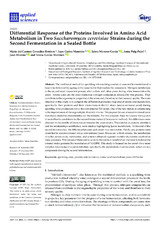Differential Response of the Proteins Involved in Amino Acid Metabolism in Two Saccharomyces cerevisiae Strains during the Second Fermentation in a Sealed Bottle

View/
Author
González-Jiménez, María del Carmen
Mauricio, Juan Carlos
Moreno-García, Jaime
Puig Pujol, Anna
Moreno, Juan
García-Martínez, Teresa
Publisher
MDPIDate
2021Subject
Sparkling wineProtein
Interact omics
Amino acid metabolism
Yeast
GO terms
METS:
Mostrar el registro METSPREMIS:
Mostrar el registro PREMISMetadata
Show full item recordAbstract
The traditional method for sparkling wine making consists of a second fermentation of a base wine followed by ageing in the same bottle that reaches the consumers. Nitrogen metabolism is the second most important process after carbon and takes place during wine fermentation by yeast. Amino acids are the most numerous nitrogen compounds released by this process. They contribute to the organoleptic properties of the wines and, therefore, to their sensory quality. The main objective of this study is to compare the differential proteomic response of amino acid metabolism, specifically their proteins and their interactions in the G1 strain (unconventional yeast) during sparkling wine production versus the conventional P29 strain. One of the new trends in winemaking is the improvement of the organoleptic diversity of wine. We propose the use of unconventional yeast that shows desirable characteristics for the industry. For this purpose, these two yeasts were grown at sealed bottle conditions for the second fermentation (Champenoise method). No differences were obtained in the middle of fermentation between the yeast strains. The number of proteins identified, and the relationships established, were similar, highlighting lysine metabolism. At the end of the second fermentation, the difference between each strain was remarkable. Hardly any proteins were identified in unconventional versus conventional yeast. However, in both strains, the metabolism of sulfur amino acids, methionine, and cysteine obtained a greater number of proteins involved in these processes. The release of these amino acids to the medium would allow the yeast to balance the internal redox potential by reoxidation of NADPH. This study is focused on the search for a more complete knowledge of yeast metabolism, specifically the metabolism of amino acids, which are key compounds during the second fermentation.
